Euro-pro 473 User Manual
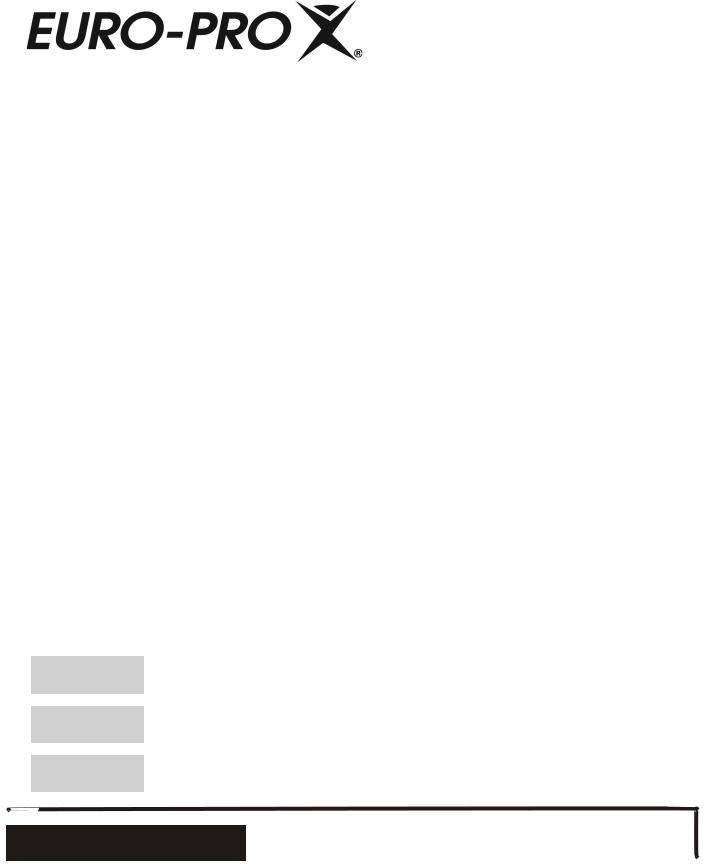
Another quality product from
INSTRUCTION MANUAL MANUAL DE INSTRUCCIONES GUIDE DE DIRECTIVES
English
Spanish
French
Model 473 / 377B / 374/ 373 / 372 / 372H
EURP-PRO Operating LLC: |
Boston, MA, 02465 |
|
4400 Bois Franc, St. Laurent, Quebec, H4S 1A7 |
|
Tel.: 1 (800) 361-4639, www.euro-pro.com |
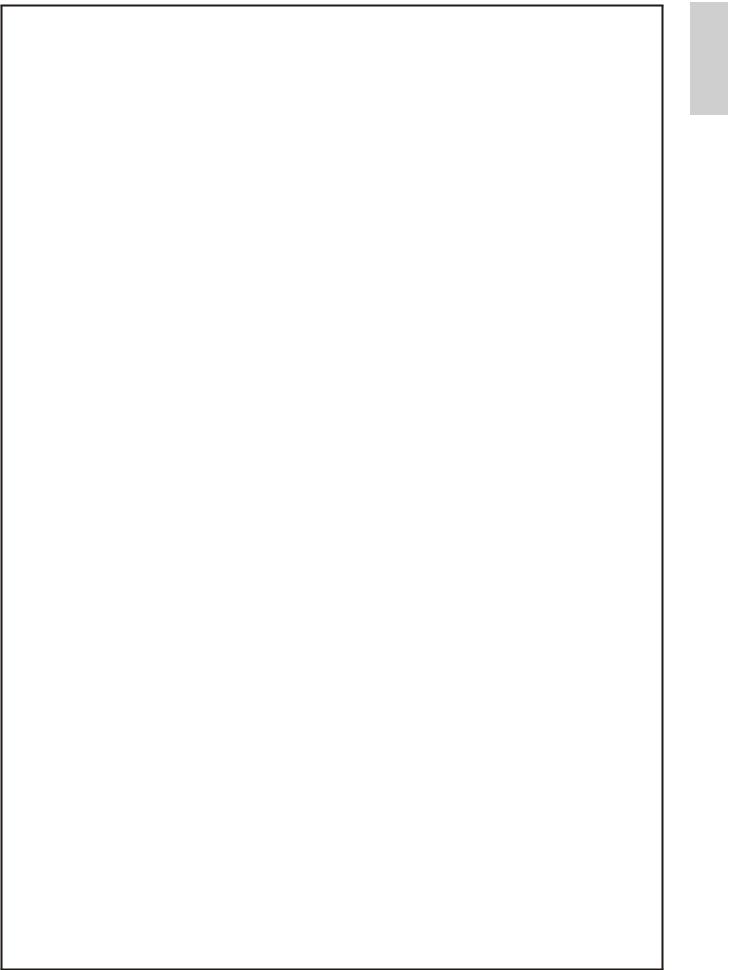
±¡° IMPORTANT SAFETY INSTRUCTIONS
When using an electrical sewing machine, basic safety precautions should always be followed, including the following.
Read all instructions before using this sewing machine. This sewing machine is designed for household use.
DANGER- TO REDUCE RISK OF ELECTRIC SHOCK:
A sewing machine should never be left unattended when plugged in. Always unplug this sewing machine from the electrical outlet immediately after using and before cleaning.
Warning -To reduce the risk of burns, fire, electric shock or injury to persons...
1. Do not allow to be used as a toy. Attention is necessary when this sewing machine is used by or near children.
2. Use this sewing machine only for its intended use as described in this manual. Use only attachments recommended by the manufacturer as contained in this manual.
3. Never operate this sewing machine if |
it has a damaged cord or plug, |
if it is not working properly, |
if it has been dropped or damaged, |
or dropped into water. Return the |
sewing machine to the nearest |
authorized dealer or service center for examination, repair,electrical or mechanical adjustment.
4.Never operate the sewing machine with any air openings blocked. Keep ventilation openings from the sewing machine and foot control free from the accumulation of lint, dust, and loose cloth.
5.Never drop or insert any object into any opening.
6.Do not use outdoors.
7.Do not operate where aerosol spray products are being used or where oxygen is being administered.
¡± 8. To disconnect, turn all controls to the off O¡±position, then remove plug from outlet.
9.Do not unplug by pulling on cord. To unplug, grasp the plug, not the cord.
10.Keep fingers away from all moving parts. Special care is required around the sewing machine needle.
11.Always use the proper needle plate. The wrong plate can cause the needle to break.
12.Do not use bent needles.
13.Do not pull or push fabric while stitching. It may deflect the needle, causing it to break.
¡± 14. Switch the sewing machine off O¡±when making any adjustments in the needle area, such as
threading needle, changing needle, threading bobbin, or changing presser foot and the like.
15.Always unplug sewing machine from the electrical outlet when removing covers, lubricating, or when making any other user servicing adjustments mentioned in the instruction manual.
16.Always unplug before replacing lamp. Replace bulb with the same rated 15 watts.
SAVE THESE INSTRUCTIONS
Rev. 05/04E
English
1
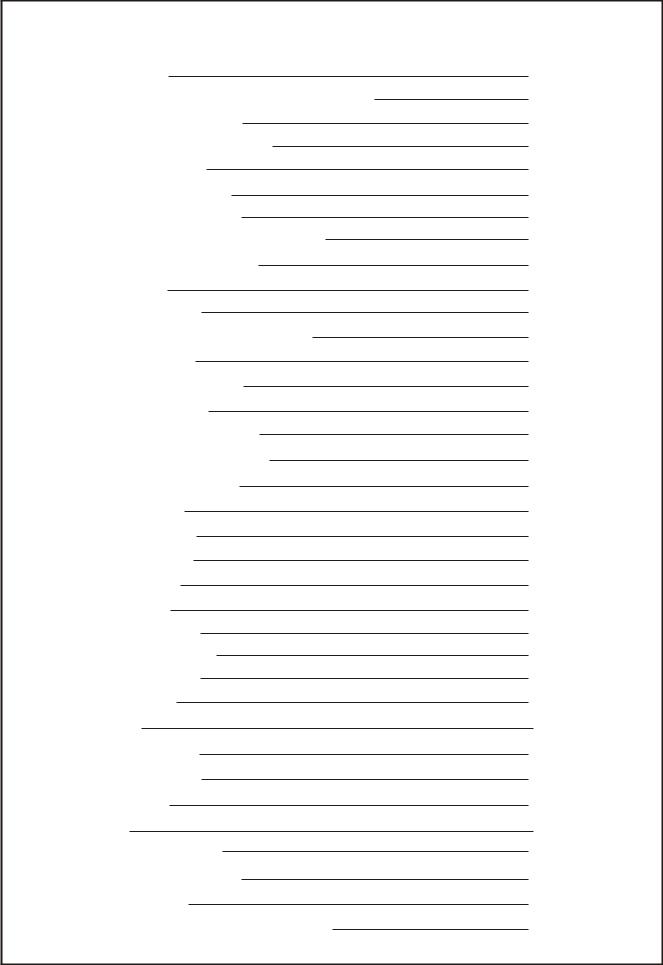
Contents
Principal parts |
3-4 |
How to connect the machine to the power supply |
4 |
How to use the foot control |
4 |
How to replace the sewing lamp |
4 |
Changing the needle |
5 |
Thread and needle chart |
5 |
To select a suitable needle |
5 |
Removing and attaching the presser foot |
6 |
|
|
Regulating the thread tension |
6 |
|
|
Reverse stitch |
7 |
The pattern selector |
7-8 |
Removing the bobbin case and bobbin |
8 |
Winding the bobbin |
9 |
Threading the bobbin case |
9 |
Threading the needle |
10 |
Drawing up the bobbin thread |
11 |
Straight stitch and zigzag stitch |
11 |
Changing sewing direction |
12 |
Fastening seams |
12 |
Triple stretch stitch |
12 |
Tricot zigzag stitch |
13 |
Smocking stitch |
13 |
Overlock stitch |
13 |
Double action stitch |
14 |
Double overlock stitch |
15 |
Sewing buttonholes |
14-15 |
Sewing zippers |
15 |
Hemming |
16 |
Sewing blind hems |
16 |
Sewing embroidery |
17 |
Darning plate |
17 |
Buttons |
17 |
Cleaning the feed dog |
18 |
Cleaning the shuttle race |
18 |
Free arm sewing |
19 |
Trouble shooting: causes and remedies |
20 |
2

1 |
2 |
3 17 |
4 |
5 |
|
|
|
|
15
14
16
13
12
11
(Accessories storage compartment) |
10 9 |
18 |
|
|
PRINCIPAL PARTS ( Model 377B) |
|
|
1.Bobbin winder thread guide |
|
|
2.Thread tension dial |
|
|
3.Pattern selector dial |
|
6 |
4.Bobbin winder spindle |
|
5.Bobbin winder stopper |
||
|
||
|
6.Balance wheel |
|
7 |
7.Stitch length dial |
|
8.Reverse button |
||
8 |
9.Needle clamp and screw |
10.Shuttle cover 11.Presser foot
12.Presser foot thumb screw 13.Needle
14.Screw for face plate 15.Face plate 16.Extension table 17.Stitch display 18.Presser foot lifter
PRINCIPAL PARTS (Model 374)
1.Bobbin winder thread guide 2.Thread tension dial 3.Pattern selector dial 4.Bobbin winder spindle 5.Bobbin winder stopper 6.Balance wheel
7.Stitch length dial 8.Reverse button 9.Needle clamp and screw
10.Shuttle cover 11.Presser foot
12.Presser foot thumb screw 13.Needle
14.Screw for face plate 15.Face plate 16.Extension table 17.Stitch display 18.Presser foot lifter
English
3
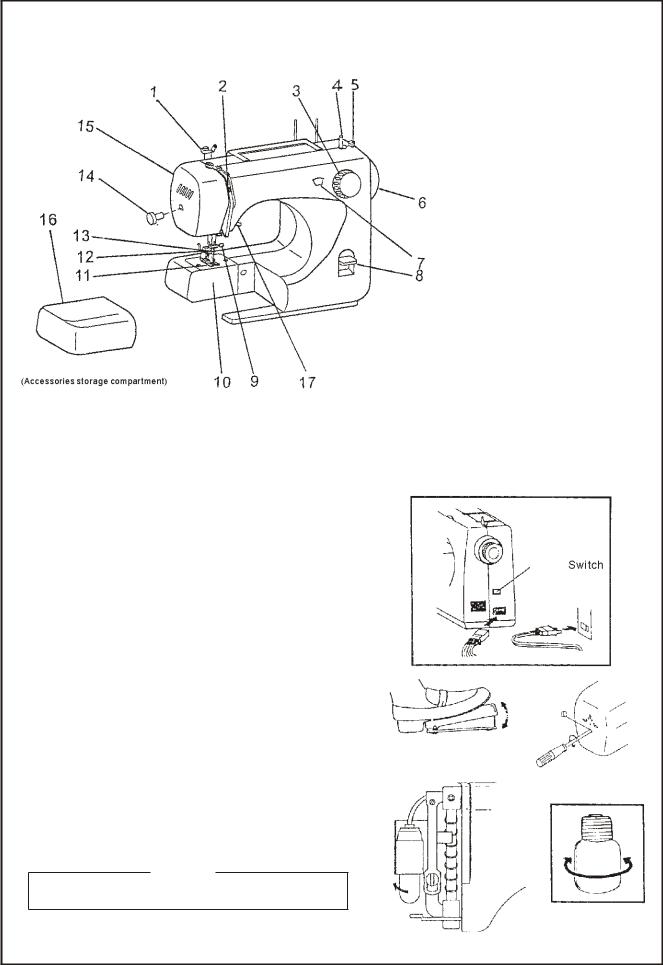
PRINCIPAL PARTS ( 473/373/372/372H)
1.Bobbin winder thread guide 2.Thread tension dial 3.Pattern selector dial 4.Bobbin winder spindle 5.Bobbin winder stopper 6.Balance wheel
7.Stitch display 8.Reverse button 9.Needle clamp and screw
10.Shuttle cover 11.Presser foot
12.Presser foot thumb screw 13.Needle
14.Screw for face plate 15.Face plate 16.Extension table 17.Presser foot lifter
HOW TO CONNECT THE MACHINE TO THE POWER SUPPLY
1.Fit the machine plug into the machine. 2.Plug the power cord to the power supply.
Note:*Before plugging in the machine, ensure the voltage and number of cycles indicated, conforms to your electrical power supply.
HOW TO USE THE FOOT CONTROL
Sewing speed can be varied by the foot control. The harder you press on the controller, the faster the machine runs.
Note:*By releasing the controller, the machine stops running automatically.
*Before using the machine, practice controlling the speed without threading.
HOW TO REPLACE THE SEWING LAMP
The sewing lamp is located behind the face plate.
Remove the face plate by loosing the screw of the face plate. Bulb type:  To remove...Unscrew
To remove...Unscrew
 To replace...Screw
To replace...Screw
Note:*Before replacing a bulb, disconnect the machine from the power supply.
*Bulbs are available from sewing machine retailers.(Use a 15-Watt bulb)
Caution!
Before leaving the machine, changing parts or doing any other work on it, always disconnect the plug from the wall socket.
4
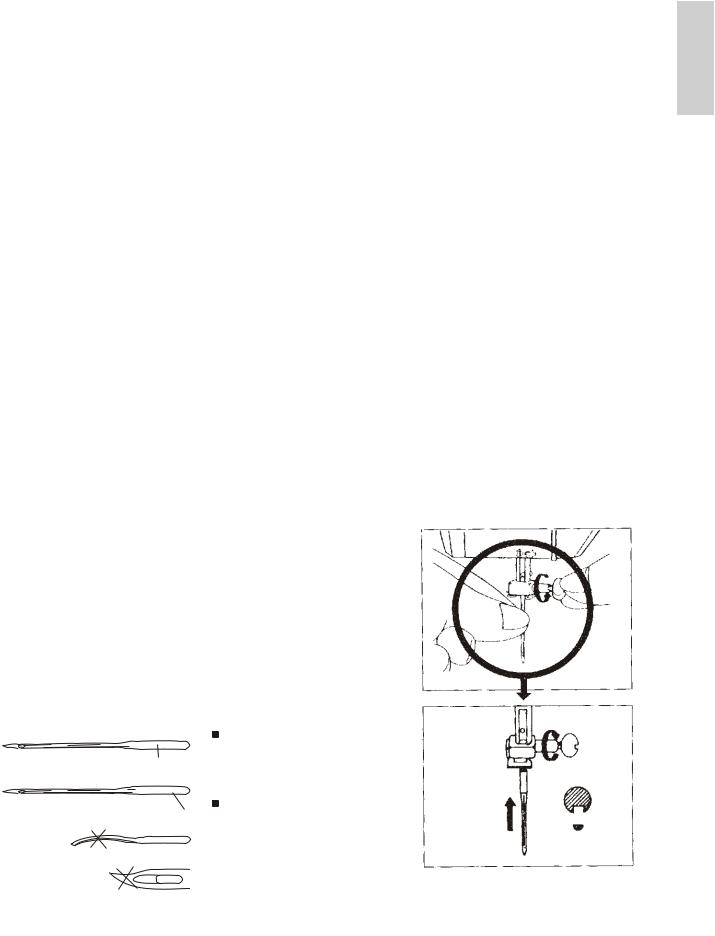
THREAD AND NEEDLE CHART |
|
|
English |
|
|
|
|
|
|
|
FABRICS |
THREADS |
NEEDLE SIZE |
|
|
|
|||
|
|
|
|
|
|
Sheer cottons, Silk, |
Fine Silk |
|
|
LIGHT |
Fine Cotton |
9 or 11 |
|
|
WEIGHT |
Synthetics, Georgette |
Fine Synthetic |
|
|
|
|
Fine Cotton Covered Polyester |
|
|
|
|
|
|
|
|
Medium Weight Cottons, Synthetics, |
50 silk |
|
|
MEDIUM |
50 to 80 Cotton |
|
|
|
WEIGHT |
Poplin, Velvet, Light Weight Woollens |
50 to 60 Synthetic |
11 or 14 |
|
|
|
Cotton Covered Polyester |
|
|
|
|
|
|
|
|
Heavy Weight Cottons, Denim |
50 Silk |
|
|
HEAVY |
40 to 50 Cotton |
14 or 16 |
|
|
WEIGHT |
Tweed, Gaberdine, Drapery |
40 to 50 Synthetic |
|
|
|
|
Cotton Covered Polyester |
|
|
|
|
|
|
|
Note: *In general, fine threads and needles are used for sewing thin fabrics, and thicker threads and needles are |
|
|||
used for sewing heavy fabrics, Always test thread and needle size on a small piece of fabric which will |
|
|||
be used for actual sewing. |
|
|
|
|
*Use the same thread for needle and bobbin. |
|
|
|
|
*When sewing stretch, very fine fabrics and synthetics, use a STRETCH needle. |
The STRETCH |
|
||
needle effectively prevents skipped stitches. |
|
|
|
|
*When sewing very fine fabrics, sew over a piece of paper to prevent yarn distortion. |
|
|
||
CHANGING THE NEEDLE
1.Turn the balance wheel towards you until the needle is in its highest position.
2.Loosen the needle clamp screw by turning its top edge towards you. Remove the needle from the clamp.
3.Place the new needle into the needle clamp with it,s flat side facing away from you. Push the needle up into needle clamp as far as possible.
4.Tighten the needle clamp screw firmly.
TO SELECT A SUITABLE NEEDLE
|
A number |
indicating the size |
(4) |
|
|
||
|
of needle is |
marked on the |
|
Stem |
stem. The higher the number, |
(3) |
|
|
the thicker the needle. |
|
|
|
A STRETCH needle is |
|
|
stretch needle |
recommended for stretch fabrics. |
|
|
|
* Do not use any needle which |
|
|
|
is bent or blunted. |
|
|
5
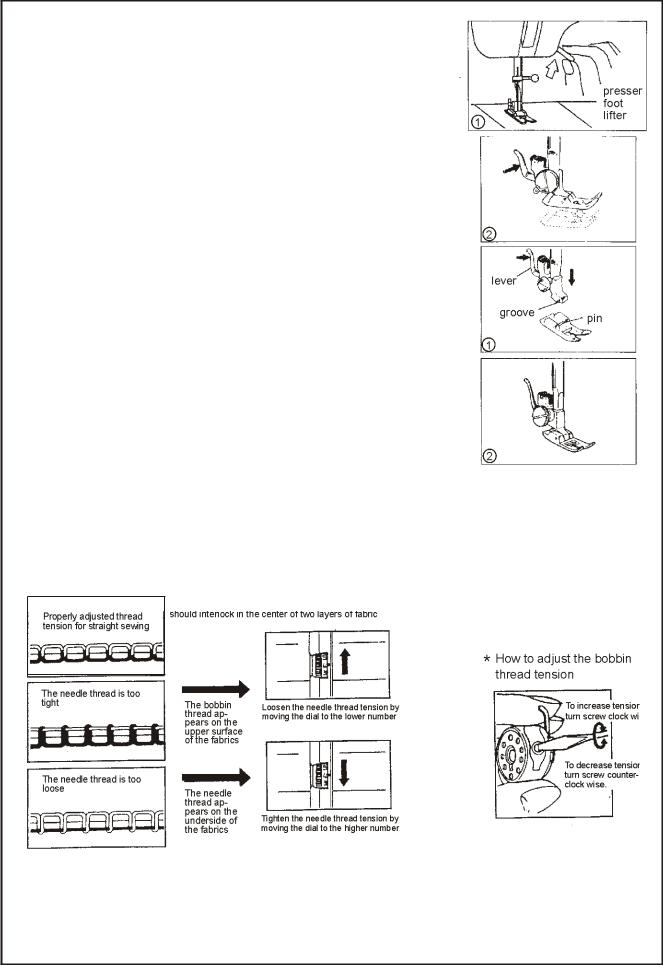
REMOVING AND ATTACHING THE PRESSER FOOT
To Remove:
1. Turn the balance wheel towards you until the needle is at its highest position
2. By lifting the lever on the back of the foot holder, the presser foot will drop off.
Note: *Do not force the presser foot to remove it.
To Attach:
1. Place the presser foot so that the pin on the foot lies just under the groove of the foot holder. Lower the foot holder.
,
2. When the presser foot lifter is raised youll fin d the presser foot is locked in place.
REGULATING THE THREAD TENSION
Generally, should any tension adjustment be necessary, the adjustment can normally be made by regulating the upper thread tension dial only. Bobbin thread tension has been adjusted at the factory and readjustment is seldom required except for special instances, thread and fabric.
Bobbin thread tension is just right when you can pull the thread from bobbin case easily with a little resistance. Thread tension may be adjusted by tightening or loosening the thread tension dial.
The needle thread and the bobbin thread
.
.
Remember |
the higher the |
number, the |
tighter the tension. Correctly balanced |
tensions |
for one fabric may not |
|
be suitable |
for another. The required |
tension depends upon the |
stiffness of |
fabric, |
thickness of the fabric, |
|
numbers of |
layers of fabric |
being sewn, |
as well as the type of stitch |
you are making. It is better to test the stitch- |
||
ing on a scrap of the fabric you are using before starting to make a garment. The general range for many fabrics is 3-5.
6
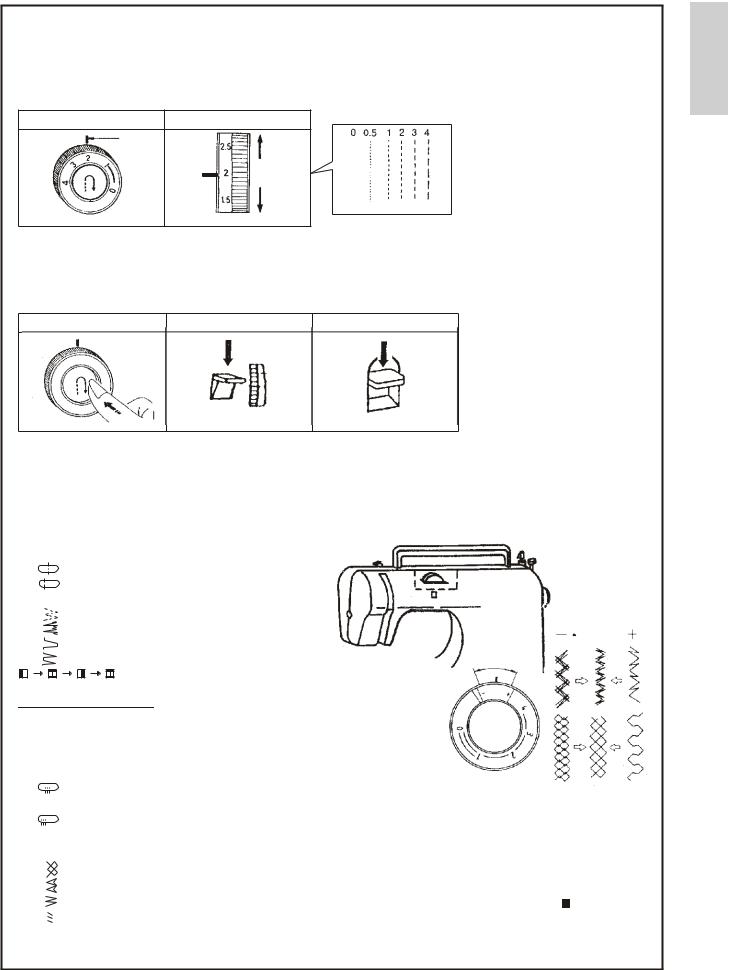
STITCH LENGTH DIAL (Model 377B and 374 only)
To change the length of the stitches proceed as follows:
Turn the dial so that the number for the required stitch length is at setting mark. The numbers indicate the approximate stitch length in mm. The smaller the numbers, the shorter the stitch.
377 |
374 |
setting mark
stitch lengths
REVERSE STITCH: (Model 473/377B/374/373/372/372H)
Press center of the stitch length dial (reversing button) and hold for reverse stitching. Fabric will immediately start feeding backwards. Release button and machine will resume normal forward sewing. Very useful for fastening ends of seams and darts without having to tie threads, and for strengthening seams.
377 374473/373/372/372H
THE PATTERN SELECTOR (Model 377B)
The desired pattern can be selected by turning the pattern selector dial. patterns shown on the panel respectively, as follows;
M( |
) |
straight stitch, middle needle position |
O( |
) |
straight stitch, left needle position |
1-5( 54321) zigzag stitch with variable width |
||
A( |
) |
tricot stitch |
B( |
) |
stretch blind stitch |
C( |
) |
double action stitch |
D( |
) |
reverse blind stitch |
|
|
automatic buttonhole sewing |
The marks on the dial correspond to the
 SS
SS
Selecting Stretch Stitch:
When sewing stretch stitch, set the stitch length dial at
S.S. .
When you release the engagement on the dial, the stretch stitch mechanism will be off automatically.
M( |
|
|
|
|
|
|
) |
triple straight stretch stitch, middle needle |
|||||
|
|
|
|
||||||||||
|
|
|
|
|
|
|
|
|
|
|
|
|
position. |
O( |
|
|
|
|
|
|
) |
triple straight stretch stitch, left needle |
|||||
|
|
|
|||||||||||
|
|
|
|||||||||||
position.
1-5( 54321) triple zigzag stretch stitch or ric-rac stitch
A( |
) |
smocking stitch |
|||||
B( |
) |
fancy stretch stitch or blanket stitch |
|||||
C( |
|
|
|
|
|
) |
double overlock stitch |
|
|
||||||
D( |
|
|
) |
overlock stitch |
|||
|
|||||||
 SS
SS
Standard djustment |
|
|
|
|
|
|
|
|
||||
Turn |
the |
stitch length dial so that |
|
|
|
|
|
|
||||
the SS mark is uppermost. |
|
|
|
|
|
|
||||||
This |
is a |
standard |
adjustment for most |
types |
|
|
|
of fabric. |
||||
For |
different types of |
fabric, adjustment may be necessary. |
||||||||||
To |
shorten |
the stretch |
stitches, turn the dial |
slightly to- |
||||||||
wards±¡° |
|
|
To lengthen, turn the dial towards¡°± |
|
|
|
|
. |
||||
On |
most |
fabrics, |
these adjustments |
allow |
for various |
|||||||
pattern possibilities. |
|
|
|
|
|
|
|
|||||
When making stretch stitches, the mark¡±° |
must always |
|||||||||||
be within the SS range - (see drawing). |
|
|
|
|
|
|
||||||
English
7
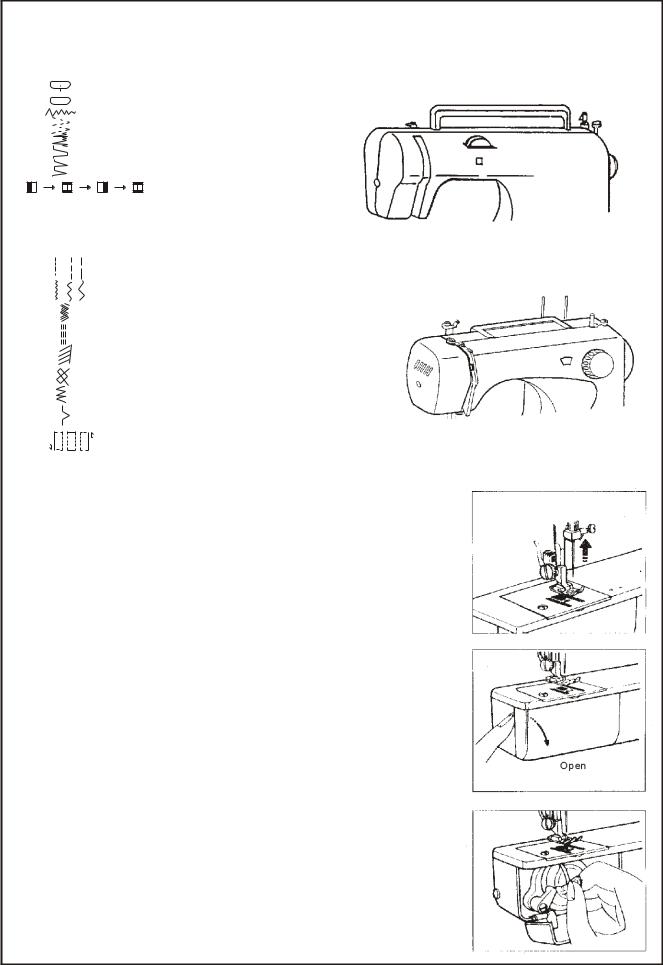
THE PATTERN SELECTOR ( Model 374)
The desired pattern can be selected by turning the pattern selector dial. The marks in the stitch display correspond to the patterns shown on the panel respectively, as follows:
A ( |
|
) |
straight stitch, middle needle position |
||
B ( |
|
) |
straight stitch, left needle position |
||
|
|||||
|
|||||
C ( |
|
) |
zigzag stitch with variable width |
||
D ( |
) |
tricot stitch |
|||
E ( |
) |
stretch blind stitch |
|||
F |
( |
|
) |
double action stitch |
|
G |
( |
|
) |
reverse blind stitch |
|
automatic buttonhole sewing
THE PATTERN SELECTOR ( Model 473/373/372/372H)
1 - 3 ( |
|
) |
straight stitch |
|
4-6 |
( |
|
) |
zigzag stitch |
7 |
( |
) |
triple zigzag stretch stitch |
|
8 |
( |
) |
triple straight stretch stitch |
|
9 |
( |
) |
overlock stitch |
|
10 |
( |
) |
smocking stitch |
|
11 |
( |
) |
tricot stitch |
|
12 |
( |
) |
shell stitch |
|
( |
|
|
|
) automatic buttonhole sewing |
RE MOVING THE BOBBIN CASE AND BOBBIN
1. Raise the presser foot and turn the balance wheel towards you until the thread takd-up lever is at its highest position.
2. Open the shuttle cover.
3. Open hinged latch of bobbin case and pull bobbin case out of machine.
Release the latch and the bobbin will fall out. As long as you hold the bobbin case latch open, the bobbin cannot drop out.
8
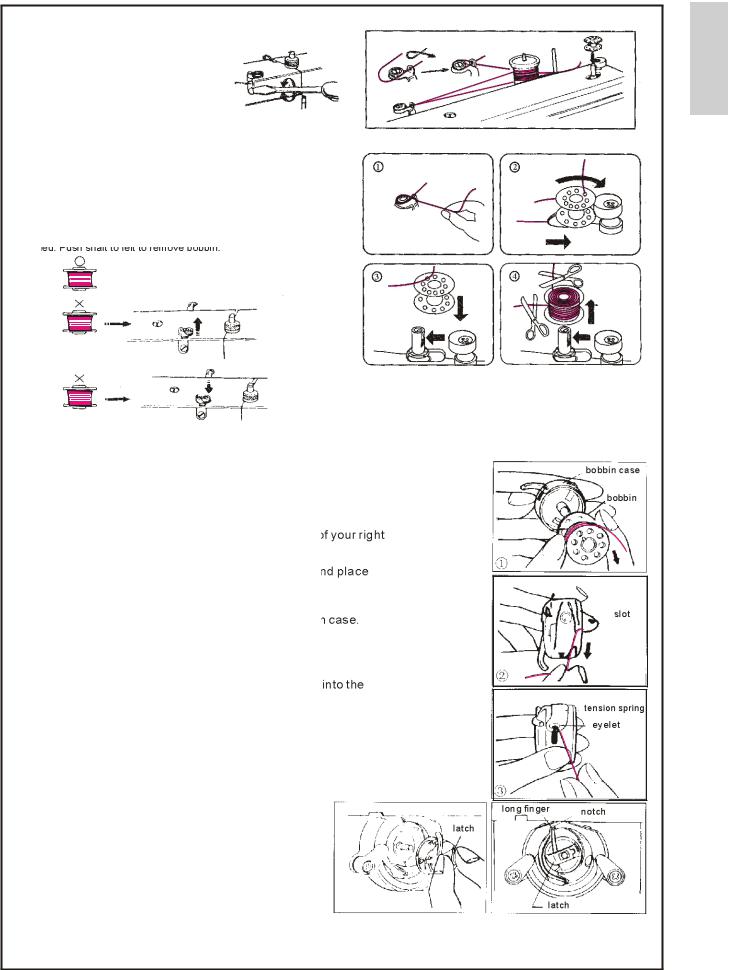
WINDING THE BOBBIN
1.Draw thread from spool through bobbin winder tension disc as shown.
2.Pull end of thread through hole in bobbin as shown.
3.Push bobbin winder shaft to far left position,
if it is not already there. Place bobbin onto shaft with end of thread coming from top of bobbin. Push bobbin winder shaft to right until it clicks. Hold onto end of thread.
4.Start machine. The thread that is held will snap or may be trimmed with a scissors, Bobbin will cease turning when completely filled. Push shaft to left to remove bobbin.
When the bobbin winding is incorrect, release the screw of the upper thread guide and adjust the thread guide up or down until the winding of the bobbin is balanced.
THREADING THE BOBBIN CASE
Hold the bobbin between the thumb and forefinger hand and pull off about 15cm (6 inches) of thread.
1.Hold the bobbin case in your left hand as shown the filled bobbin inside.
2.Pull the thread into the slot in the edge of the bobbin
3.Now pull the thread under the tension spring and thread eyelet.
To insert the bobbin case and bobbin......
Ensure that about 15 cm (6 inches) of thread extends out of bobbin. Hold the bobbin case so that long finger on case points up. Open the latch of bobbin case. Slip the bobbin case over the center pin of hook and press in place until the long finger of the bobbin case enters the notch entirely to lock the bobbin in place. Release latch and press it down.
English
9
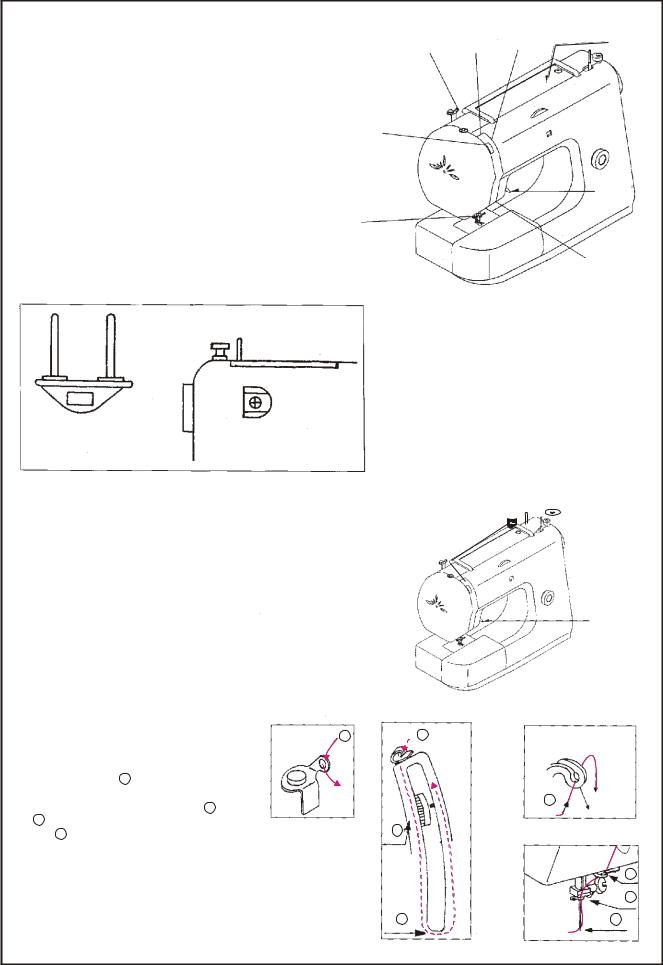
|
|
|
1 |
2 5 |
A |
THREADING |
THE NEEDLE |
|
3 |
|
|
Install the spool pin behind the machine |
|
|
|
||
|
|
|
|
||
(as shown in fig A). |
|
|
|
|
|
Place spool on spool pin, with thread |
|
|
|
|
|
coming from the back of the spool. Place |
|
|
|
B |
|
the take - up lever |
5 in the highest |
7, |
8 |
|
|
|
|
||||
position. |
6, |
|
|
||
|
|
|
|
|
|
|
|
|
|
|
4 |
fig A
1.Raise the presser foot using the foot lever marked B .
2.Draw the thread through the thread guides on the top cover as shown in Fig.Ú¢Ù . 1 & 2.
3.Hold the spool still with right hand, pull the end of the thread between the tension disk as shown in Fig. 3.¢Û
4.Following the slotted threading path, pull the thread down to the thread check spring (inside) and lead it across from left to right.
1 |
2 |
5. Pull the thread upward and slip into the slotted hole of thread take-up level from left to fight 5 .
B
6. Draw the thread through guides 6 and
7 , and thread the needle from front to rear 8 , leave the thread about 15cm(6 inches) long underneath the presser foot.
5
3
6
7
4 |
8 |
10

DRAWING UP THE BOBBIN THREAD
1.Hold the end of the needle thread with your left hand.
needle thread
1
2.Turn the balance wheel slowly towards you with your right hand until the needle goes down and comes up. Then stop the balance wheel when the take-up lever is at its highest position.
Lightly draw up the needle thread forming a loop with the bobbin thread.
|
|
|
|
|
|
|
|
|
|
|
|
|
2 |
|
3.Puil about 15cm |
(6 inches) of |
both threads away from you |
|
|
|
needle |
||||||||
under the presser foot. |
|
|
|
|
|
|
|
|
|
|
thread |
|||
|
|
|
|
|
|
|
|
|
|
|
|
|
|
bobbin |
|
|
|
|
|
|
|
|
|
|
|
|
|
|
thread |
|
|
|
|
|
|
|
|
|
|
|
|
|
3 |
|
|
STRAIGHT STITCH AND ZIGZAG STITCH |
|
|
|
|
|
|
|
||||||
|
|
|
|
|
|
|
|
|
|
|
|
|
|
|
|
|
|
|
377B |
|
374 |
|
|
|
|
|
|
473/373/372/372H |
|
|
Presser foot |
|
|
zigzag foot |
|
|
|
zigzag foot |
|
|
|
|
||
|
|
|
|
|
|
|
|
|
|
|
|
|
|
|
|
|
|
|
|
O ( |
|
|
|
|
|
|
|
|
|
|
Pattern selector |
|
M ( |
) or |
) |
|
A ( |
) or B ( |
|
) |
( |
|
) (for straight stitch) |
|
|
|
|
|
|
||||||||||
|
|
|
|
|
||||||||||
|
|
|
(for straight gtitch) |
|
|
(for straight stitch) |
|
|
( |
|
) (for zigzag stitch) |
|||
|
|
|
|
|
|
|
|
C ( |
) (for zigzag stitch) |
|
|
|||
|
|
|
1 - 5 (54321) (for zigzag stitch) |
|
|
|
|
|
||||||
|
|
|
|
|
|
|
|
|
|
|
|
|
|
|
|
Stitch length dial |
|
|
0.3-4 |
|
|
|
0.3-4 |
|
|
|
- |
||
Starting Sewing
1.Be sure both the threads are drawn back under the presser foot.
2.While holding the threads with your left hand, turn the balance wheel toward you to bring the needle into the fabric where you wish to start sewing.
3.Lower the presser foot, and press the speed controller gently, then start sewing slowly.
*Sew a few reverse stitches by pushing reverse |
button |
for |
reinforcing the end of seams. |
|
|
*Raise the needle to its highest position before |
turning |
the |
pattern selector dial and stitch width dial. |
|
|
English
11
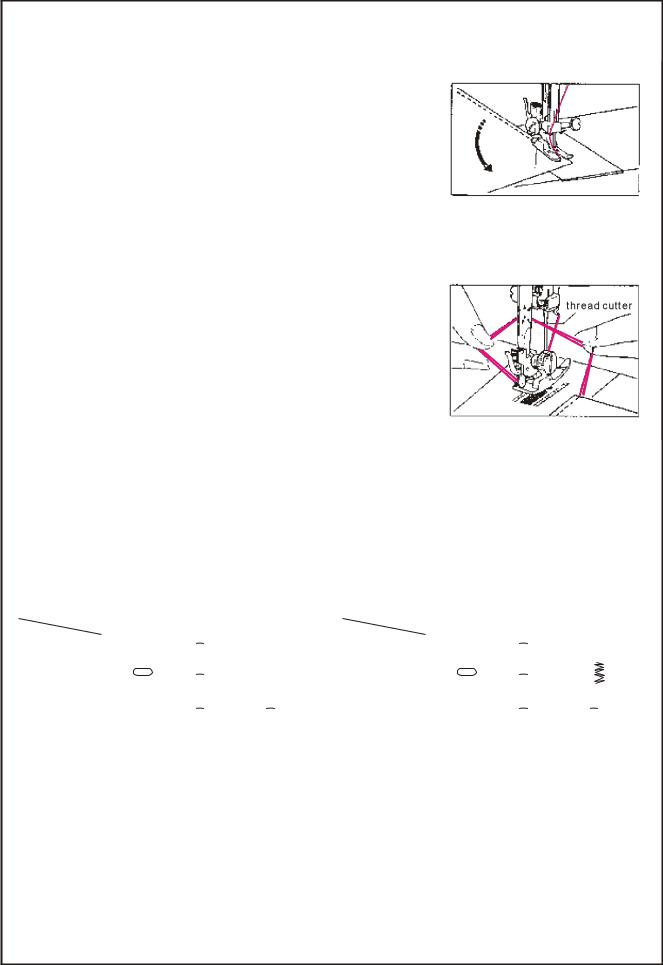
C hanging S ewing Directions |
|
||
1. S top the ma chine, a nd turn |
the ba la nce wheel towa rd you to |
||
|
bring |
the needle down into the fabric . R a is e the pres s er foot. |
|
2 |
. P ivot |
the fa bric a round the |
needle to cha nge direction a s |
|
des ired. |
|
|
3 |
. L ower |
the pres s er foot and |
continue s ewing. |
F as tening S eams
1. F or fa s tening the ends of s ea ms , pres s in the revers ing button a nd s ew severa l revers e s titches .
2. To remove the fabric, ra is e the pres s er foot a nd dra w the fa bric a wa y from you.
3. C ut threa ds |
on |
threa d cutter a t the rea r of pres s er ba r or |
|
with a |
pa ir of |
s cis s ors . |
|
L ea ve |
a bout 15 |
cm (6 inches ) of hrea d ha nging from the |
|
needle eye .
T R IP L E S T R E T C H S T IT C H (Model 473/374/373/372/372H)
If you wis h to s ew s tretch fa brics , this is the right s titch to a void threa d brea king. T his is a ls o very s uita lbe for s ea ms tha t need grea t s trength, e . g. crutch s ea ms or pocket s ea ms .
T R IP L E S T R AIG HT S T R E T C H S T IT C H
|
377B |
|
374 |
473/373/372/372H |
||||||
|
|
|
|
|
|
|
|
|
|
|
Presser foot |
zigzag foot |
|
zigzag foot |
|||||||
Pattern selector |
M ( |
|
|
|
) |
|
8( |
|
|
) |
|
|
|
|
|
|
|||||
|
|
|
|
|
|
|||||
|
|
|
|
|
|
|
|
|
|
|
|
|
|
|
|
|
|
|
|||
Stitch length dial |
S .S . |
|
|
|
|
|
|
|||
|
|
|
|
|
|
|
|
|
|
|
T R IP L E ZIG ZAG S T R E T C H S T IT C H
|
377B |
|
374 |
473/373/372/372H |
||||||||
|
|
|
|
|
|
|
|
|
|
|
||
Presser foot |
zigzag foot |
|
zigzag foot |
|||||||||
Pattern selector |
O( |
|
|
|
|
|
|
) |
|
7( |
) |
|
|
|
|
|
|
|
|
|
|||||
|
|
|
|
|
|
|
|
|||||
|
|
|
|
|
||||||||
|
|
|
|
|
|
|
|
|
|
|
|
|
|
|
|
|
|
|
|
|
|
|
|
|
|
Stitch length dial |
S .S . |
|
|
|
|
|
||||||
|
|
|
|
|
|
|
|
|
|
|
|
|
N ote : * U s e a S T R E T C H needle .
T he blue tipped s ha nk needle effectively prevents s kipped s titches .
12
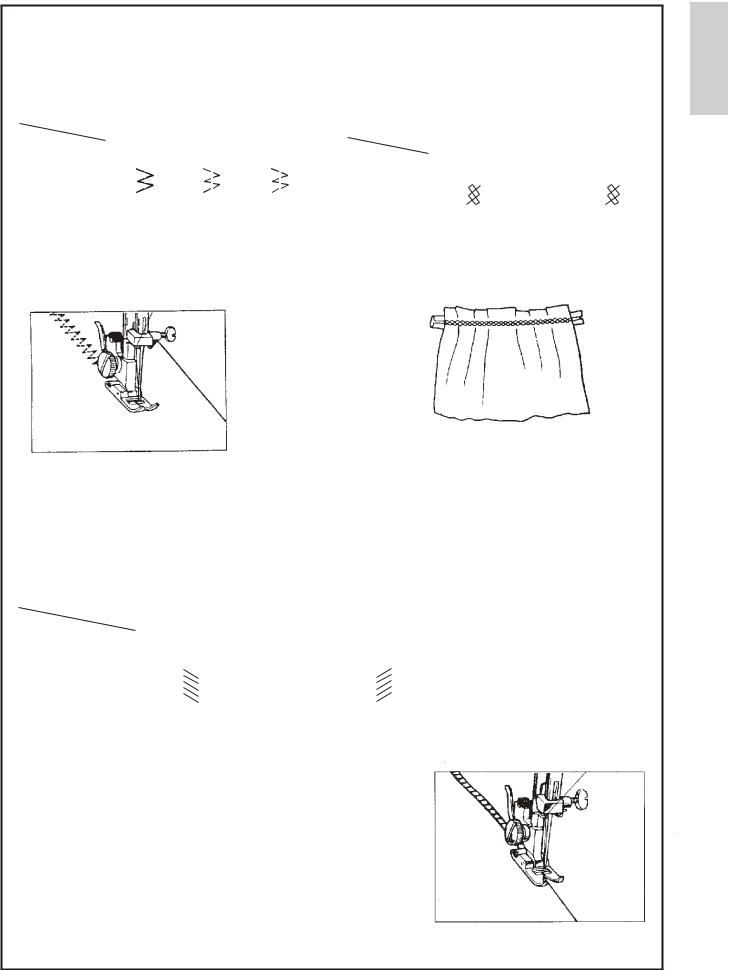
T R IC OT ZIG ZAG S T IT C H
|
T his s titch is |
very s uita ble for da rning tea rs . It ca n |
|
|
|||||
|
a ls o be us ed |
for reinforcing s tretch ma teria ls a nd |
|
|
|||||
|
s ewing on fa bric pa rts . |
|
|
|
|
|
|
||
|
|
|
|
|
|
|
|
|
|
|
|
|
377B |
|
374 |
|
473/373/372/372H |
||
|
|
|
|
|
|
|
|||
|
Presser foot |
|
zigzag foot |
zigzag foot |
zigzag foot |
||||
|
Pattern selector |
A ( |
) |
D ( |
) |
11( |
) |
|
|
|
|
|
|
|
|
|
|
||
|
S titch length dial |
0.3 to 4 |
0.5 to 4 |
|
- |
|
|
||
|
|
|
|
|
|
|
|
|
|
N ote: *U s e a S T R E T C H |
needle . |
|
|
|
|
||||
|
T he s tretch needle effectively prevents |
|
|
||||||
|
s kipped s titches . |
|
|
|
|
|
|
||
S MOC K ING S T IT C H
W ith a na rrow s trip of fa bric directly under the line
of ga thering, s titch over the ga thers . T he des ign will be a s erie s of s ma ll dia monds .
W hen s mocking a ga rment, the s titching s hould be done before the piece is s ewn into the ga rment.
|
377B |
|
374 |
473/373/372/372H |
|
|
|
|
|
|
|
Presser foot |
zigzag foot |
|
|
zigzag foot |
|
|
|
|
|
|
|
Pattern selector |
A ( |
) |
|
10( |
) |
|
|
|
|
|
|
Stitch length dial |
S .S . |
|
|
- |
|
OV E R L OC K S T IT C H
W ith this s ea m it is pos s ible to prevent ra w edges , es pecia lly on ea s ilyfra ying fa brics , with a good-locking and la s ting edge finis h.
|
|
377B |
|
374 |
473/373/372/372H |
|||||||
|
|
|
|
|
|
|
|
|
|
|
|
|
Presser foot |
|
zigzag foot |
|
|
|
|
zigzag foot |
|
||||
|
|
|
|
|
|
|||||||
|
|
|
|
|
|
|
|
|
|
|
|
|
|
|
|
|
|
|
|
|
|
|
|
||
Pattern selector |
D ( |
|
) |
|
|
|
9( |
|
|
|
) |
|
|
|
|
|
|
||||||||
|
|
|
|
|
|
|
|
|
|
|
|
|
S titch length dial |
S .S . |
|
|
|
|
|
|
|
|
|
||
|
|
|
|
|
|
|
|
|
||||
P la c e the fa bric unde r the pre s s e r foot s o tha t the s titc he s a re ma de |
|
|||||||||||
ove r the e dge . |
|
|
|
|
|
|
|
|
|
|
|
|
L owe r the pre s s e r foot a nd s ta rt se wing. |
|
|
|
|
|
|||||||
G uide the ma te ria l lightly a s s hown. |
|
|
|
|
|
|||||||
S e w on a pie c e of wa s te fa bric to c he c k the ma c hine s e tting. |
|
|||||||||||
T he ove rloc k s titc he s a re forme d c orre c tly whe n the ne e dle s e ws |
|
|||||||||||
to the right a nd |
jus t mis s e s the fa bric edge . |
|
|
|
|
|
||||||
N ote : *U s e a |
S T R E T C H ne e dle . |
|
|
|
|
|
|
|
|
|
||
T he s tre tc h ne e dle e ffec tive ly pre ve nts s kippe d s titc he s .
English
13
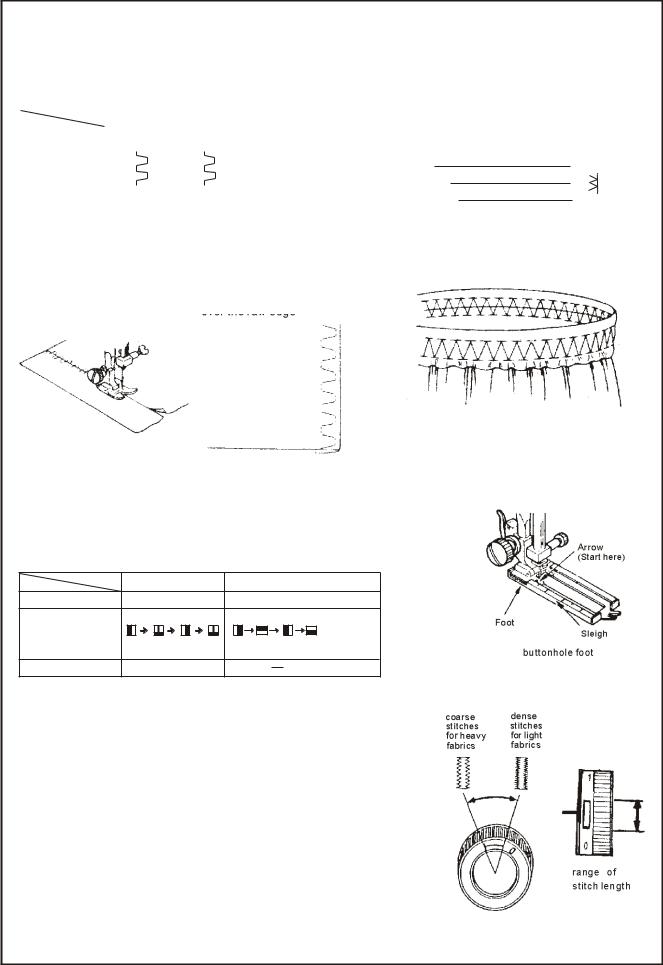
DOUB L E AC T ION S T IT C H
T his is a good |
s tilch to |
us e in a tta ching or |
binding |
||||||
ela s tic fa brics a nd s tretch la ce , lingerie s tretch knit. |
|||||||||
T he s titch is decora tive a s well a s us eful. |
|
|
|
||||||
|
|
|
|
|
|
|
|
|
|
|
|
377B |
|
|
374 |
|
473/373/372/372H |
||
Presser foot |
|
zigzag foot |
zigzag foot |
|
|
|
|
||
|
|
|
|
|
|||||
Pattern selector |
|
C ( |
) |
F ( |
) |
|
|
|
|
|
|
|
|
|
|||||
|
|
|
|
|
|
|
|
||
Stitch length dial |
|
1 to 2.5 |
1 to 2.5 |
|
|
|
|
||
|
|
|
|
|
|||||
|
|
|
|
|
|
|
|
|
|
DE C OR AT IVE E DG ING
DOUB L E OVE R L OC K S T IT C H (Model E P 377B only)
U s e this vers a tile s titch to |
ins ert ela s tic in ga rments . |
S imply s titch ela s tic into |
pla ce, ma king s ure it is |
evenly s pa ced. To do this , ma rk the correct length piece into qua rters , then ma tch thes e ma rkings with center front a nd s ide s ea ms .
P res s er foot |
z igz a g foot |
||
P a ttern s elector |
C ( |
|
) |
|
|||
S titch length dia l |
|
||
S . |
S . |
|
|
|
|
|
|
T urn the |
ra w edgeunder 2cm a nd pres s . P la ce the |
||
fa bric |
right s ide up with the middle of the turnover |
||
under |
the |
center of |
the pres s er foot, s o tha t the |
s titch s ews on to the |
fold a nd jus t over the raw edge. |
||
undernea th. |
|
||
S E WING B UT TONHOL E S
T he built -in buttonhole mecha nis m of this ma chine ma kes it pos s ible to s ew button hole s in a s hort time without turning the ma teria l.
|
377B/374 |
473/373/372/372H |
Presser foot |
buttonhole foot |
buttonhole foot |
Pattem selector |
|
|
S titch length dial |
0.5 to 1 |
|
R a is e the foot a nd the needle to its highes t pos ition. R epla ce the foot with the tra ns pa rent buttonhole foot for s ewing buttonholes .
Ma rk the loca tion a nd the des ired length of buttonhole on the fa bric us ing a pencil or ta ilor, s cha lk.
N ote: (Model 377B and 374 only) *To find the mos t s uita ble s titch length, it is better
to s ew a s a mple buttonhole on a piece of wa s te fa bric .
* W hen s ewing very fine fa brics a nd s ynthetics , de - crea s e the pres s ure of foot a nd s ew over a piece of
pa per to prevent ya rn dis - tortion.
* T he ma rk |
on |
the s titch |
|
length dia l s hows a ra nge of |
|||
buttonhole |
s ewing. |
An |
|
a djus tment |
ca n be ma de |
||
by s etting |
the |
ma rk, |
a s |
shown.
*B uttonhole s titch length is
adjus ta ble only on one s ide .
14
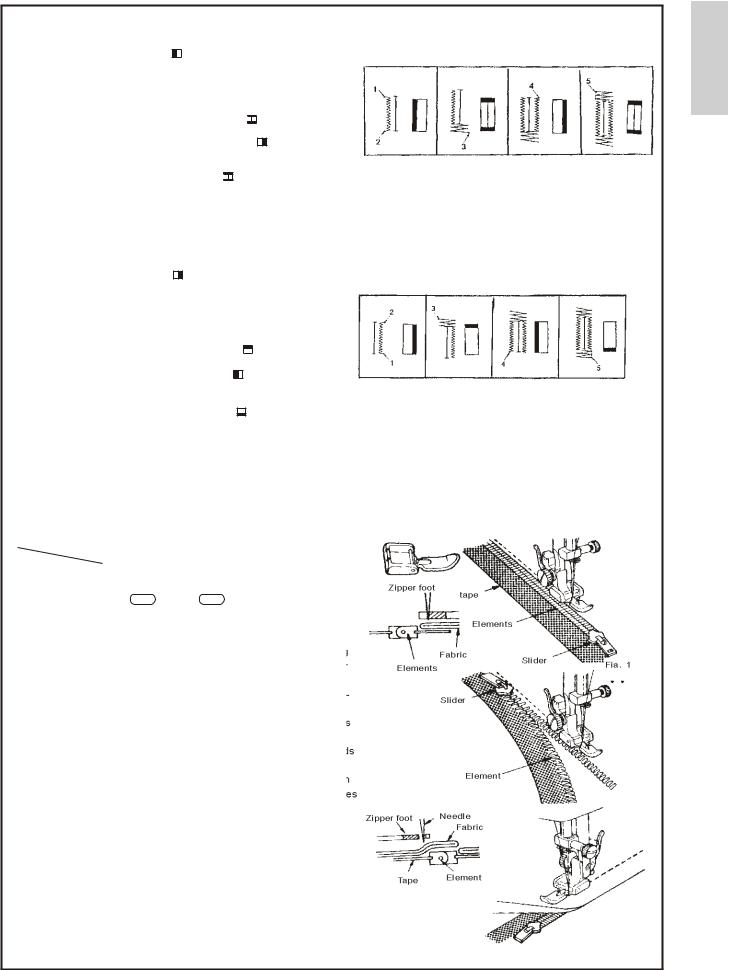
SEWING BUTTONHOLES (Model 377B and 374)
1. Set the pattern selector at¡°¡± |
. Then pass the needle thread |
|||||
throughthe opening in the buttonhole foot and draw both needle |
||||||
and bobbin threads to |
the left side. Turn the balance wheel |
|||||
towards you until the needle comes to the point(1). |
|
|
|
|||
2.Lower the foot and sew slowly until the desired length is sewn, |
||||||
then stop the machine at |
(2). |
|
|
|
|
|
3. Raise the needle and set the selector at |
. |
Then sew |
||||
|
|
±¡° |
|
|
|
|
several stitches of bar tack until the needle is at point (3). |
|
|||||
4. Raise the needle and set the selector at |
|
then sewthe |
||||
|
|
±¡° |
|
|
|
|
right side of buttonhole the same length as the left side of |
||||||
buttonhole. Stop the machine at (4). |
|
|
|
|
||
5. Raise needle and set the selector at |
then sew several |
|||||
|
|
¡°± |
|
|
|
|
stitches of final bar tack. Stop the machine with the needle at |
||||||
point (5). . To lock threads, set the pattern selector at |
B |
(zero |
||||
point of zigzag width). |
And sew a few stitches. |
°¡ |
§ |
|||
|
|
|
||||
6.Cut thebuttonhole open carefully using a seam ripper, taking care not to damage the bar tacks.
SEWING BUTTONHOLES(Model 473/373/372/372H)
1. Set the pattern selector at |
Then pass the needle thread |
¡°¡± |
|
through the opening in the buttonhole foot and draw both of |
|
needle and bobbin threads to the right side. Turn the balance |
|
wheel towards you until the needle comes to the point (1). |
|
2.Lower the foot and sew slowly until a desired length is sewn, then stop the machine at (2).
3. |
Raise the needle and set the selector at |
then sew |
|
¡°¡± |
|
4. |
several stitches of bar tack until the needle is at point (3). |
|
Raise the needle and set the selector at |
then sew the |
|
|
¡°¡± |
|
|
left side of buttonhole just as the same length as the right side of |
|
|
buttonhole. Stop the machine at (4). |
|
5. |
Raise the needle and set the selector at |
then sew several |
|
¡°¡± |
|
|
stitches of final bar tack. Stop the machine with the needle at |
|
|
point (5). |
|
6.Cut the buttonhole open carefully using a seam ripper, taking care not to damage the bar tacks.
Note: To make a heavier buttonhole, sew twice by repeating the same procedure.
( 377B and 374 only)
(473/373/372/372H)
S E WING ZIP P E R S
|
|
|
377B |
|
|
|
374 |
473/373/372/372H |
|
||||||||
Presser foot |
|
zi pper foot |
|
zipper foot |
zipper foot |
|
|||||||||||
|
|
|
|
|
A ( |
|
) |
|
|
|
|
|
|
|
|||
Pattern selector |
|
M ( |
|
|
) |
|
|
1-3( |
|
|
|
) |
|
||||
|
|
|
|
|
|||||||||||||
|
|
|
|
|
|
||||||||||||
|
|
|
|
|
|
|
|
|
|
|
|
|
|
|
|
|
|
|
|
|
|
|
|
|
|
|
|
|
|
|
|
|
|
|
|
S titch length dial |
|
1 to 4 |
|
|
1 to 4 |
|
|
|
|
|
|
|
|||||
|
|
|
|
|
|
|
|
|
|
||||||||
R a is e the |
foot |
|
a nd the ne edle |
to its highe s t pos ition |
by turning |
||||||||||||
the ba la nce whe el towa rds you. |
R epla c e the foot with |
the z ipper |
|||||||||||||||
foot. |
|
|
|
|
|
|
|
|
|
|
|
|
|
|
|
|
|
1 . P in or |
ba s te |
|
the z ipper ta pe to |
the fa bric a nd pla c e the work- |
|||||||||||||
piec e in pos ition unde r |
the foot. |
|
|
|
|
|
|
|
|||||||||
Atta ch s na p |
on z ipper |
foot s o |
tha t the |
nee dle pa s s e s on its |
|||||||||||||
left ha nd s ide . |
|
|
|
|
|
|
|
|
|
|
|
|
|||||
* W he n |
s ta rting s e wing, |
both nee dle a nd bobbin thre a ds ends |
|||||||||||||||
s hould be put a wa y under |
the foot. |
|
|
|
|
|
|
|
|||||||||
2 . S ew |
on the |
|
right s ide |
of the |
z ipper by guiding Z ipper te eth |
||||||||||||
a s c los e a s pos s ible to the ne edle drop. B e fore the foot re a c he s
the s lide r |
on |
the z ipper ta pe, ra is e the foot a nd open the |
z ipper by |
kee ping the ne edle in the fa bric . |
|
L owe r the foot a nd s e w on the re ma ining of the s e a m, |
||
3 . To s e w the |
le ft s ide z ipper cha nge pos ition of foot to bring |
|
the foot to the le ft s ide of the nee dle . S e w on in the s a me wa y a s you did on the right s ide of z ipper.
Z ippe r foot
|
ta pe |
|
|
|
E le me nts |
|
|
|
F a bric |
S lide r |
|
E le me nts |
|
F ia . 1 |
|
|
|
||
|
|
|
|
|
S lide r |
|
|
|
E le me nt |
Z ippe r foot |
N e edle |
|
F a bric |
Ta pe |
E le me nt |
|
E nglish
15

HE MMING (Model 377B only)
P re s s e r foot |
he mme r foot |
|
|
||
P a ttern s elector |
M ( |
) |
|
||
S titch length dia l |
1 to 4 |
|
R aise the |
foot |
|
and |
the needle |
to its highest |
position. R eplace the |
|||||||||
foot with |
the |
hemmer foot. |
|
|
|
|
|
|
|
|
|||||
F old over the |
fabric |
edge by about 3mm (1/8 |
inches |
) and place it |
|||||||||||
under |
the |
foot. |
S ecure |
the folded edge |
with |
a few stitches . |
Take |
||||||||
out the |
workpiece and draw |
the |
hem into |
the |
hemmer foot by |
||||||||||
pulling |
on the threads . |
|
|
|
|
|
|
|
|
|
|||||
Lower |
the |
foot and swe the hem. |
|
|
|
|
|
|
|
||||||
During s ewing, fold the fabric |
to the left |
a little |
and allow |
it to |
|||||||||||
run into the hemmer foot. |
|
|
|
|
|
|
|
|
|||||||
Make |
sure that the fabric |
does |
not move |
under |
the |
right half of |
|||||||||
the foot. T he |
|
fabric |
must be |
fed into |
the scroll |
of |
the hemmer |
||||||||
sufficiently |
so |
that |
the |
workpiece |
edge |
runs freely |
through the |
||||||||
groove under the foot. |
|
|
|
|
|
|
|
|
|
||||||
S E WING B L IND HE MS (Model 473/377/374/373/372/372H)
|
|
|
|
|
|
377B |
|
|
|
|
374 |
|
473/373/372/372H |
||||||
Presser foot |
|
|
blind hem foot |
|
|
blind hem foot |
|
|
|
|
|
||||||||
|
|
|
|
|
|
|
|
|
|||||||||||
|
|
|
|
|
|
|
|
|
|
|
|
|
|
|
|
|
|||
Pattern selector |
|
B ( |
|
) |
|
|
|
E ( |
|
) |
|
|
|
|
|
|
|||
|
|
|
|
|
|
|
|
|
|
|
|
||||||||
|
|
|
|
|
|
|
|
|
|
|
|
|
|
|
|||||
Stitch length dial |
|
|
1 to 3 |
|
|
|
|
1 to 3 |
|
|
|
|
|
|
|||||
|
|
|
|
|
|
|
|
|
|
|
|
||||||||
|
|
|
|
|
|
|
|
|
|
|
|||||||||
1. |
T urn |
up the hem |
to |
the |
desired width |
and press . ( F ig. 1) |
|||||||||||||
2. |
F old |
hem |
back against |
the |
|
right side of |
the garment |
with |
|||||||||||
|
top edge of hem extending |
about 4 mm |
(1/6 inches) |
|
to the |
||||||||||||||
|
right |
side of |
|
the garment folded. (F ig. 2) |
|
|
|
|
|
|
|||||||||
3. |
P lace the garment under |
the |
|
foot |
so that |
double-folded edge |
|||||||||||||
|
runs |
along |
the |
hemlguide |
and |
lower the |
foot. |
|
|
|
|
||||||||
|
S ew |
slowly |
for |
better |
control, |
making |
sure |
|
the |
narrow |
|||||||||
|
zigzag stitches are |
sewn |
on |
the hem edge and wide |
zigzag |
||||||||||||||
|
stitches will just |
catch |
one |
thread |
of |
folded |
edge. (F ig. 3) |
||||||||||||
4. |
Unfold the |
|
fabric |
and |
you |
will |
have |
a bling |
|
stitch |
hem |
||||||||
|
(F ig. |
4) |
|
|
|
|
|
|
|
|
|
|
|
|
|
|
|
|
|
( F ig. 1) 4mm (1/6,, )
(F ig. 2)
G uide
a djus ting
s c re w(F ig. 1)
G uide
F oided edge
(F ig. 3)
(F ig. 4)
16
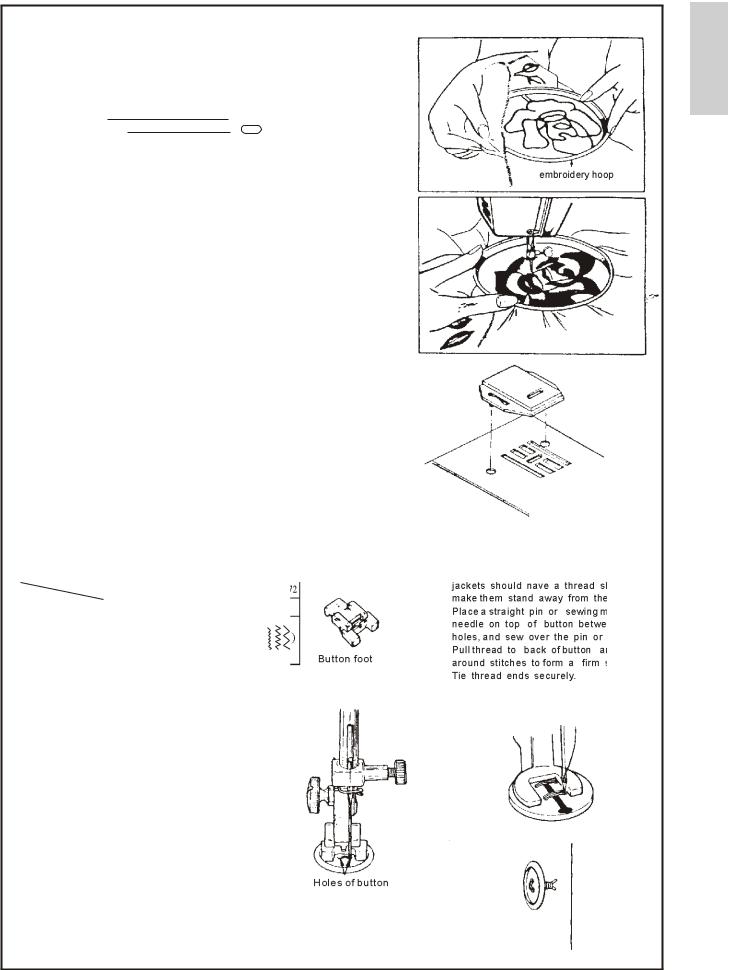
SEWING EMBROIDERY
Presser foot |
darning plate |
||
Pattern selector |
( |
|
) or |
|
|||
|
|||
|
zig |
|
zag |
|
|
|
|
Raise and take off the foot.
Place the fabric in embroidery hoop. Place darning plate over needle plate (see below). Lower the presser foot lifter. Hold the embroidery hoop firmly with your hand.
While sewing the desired pattern, move the embroidery hoop slowly and do not allow your fingers to get near the needle. *Set the needle thread tension a little looser so that the bobbin thread is not pulled through to the right side of fabric.
(See page 13).
*It is recommended to mark the required embroidery pattern on the right side of the fabric with a pencil or tailor,s chalk.
DARNING PLATE
There are a few times when you want to control the feeding of the fabric yourself. Raise needle to its highest position and raise presser foot. Place darning plate over needle plate aligning two pins of darning plate with holes of needle plate. You may then determine the movement of the fabric yourself. See above for embroidery.
BUTTONS
|
|
|
377B |
|
374 |
473/373/372/372H |
||
|
|
|
|
|
|
|
|
|
Presser foot |
|
button foot |
|
|
|
|
button foot |
|
|
|
|
|
|
||||
|
|
|
|
|
|
|
||
Pattern selector |
1-5(54321) |
|
|
|
|
4-6( |
||
|
|
|
|
|||||
|
|
|
|
|
|
|
|
|
1. Align |
two |
holes of button with |
slot |
|
||||
of presser foot and lower foot to |
|
|||||||
hold |
the |
button securely. |
|
|
|
|
||
2.Turn hand wheel manually until needle point is just above button.
3.Adjust stitch selector so needle enters right hole of button.
4.Turn hand wheel by hand so needle enters second hole. The stitch selector may need to be adjusted again. Stitch a number of times.
NOTE:
You may find it helpful to use transparent tape to position your button and to keep it in place during sewing. Tear away after stitching.
5.Finish sewing with an extra two inches of thread remaining. Draw these threads to reverse side of garment and tie.
Rev. 1
English
Thread Shank
Sew-through buttons on coats and hank to fabric. achine the needle. and wind
shank.
17
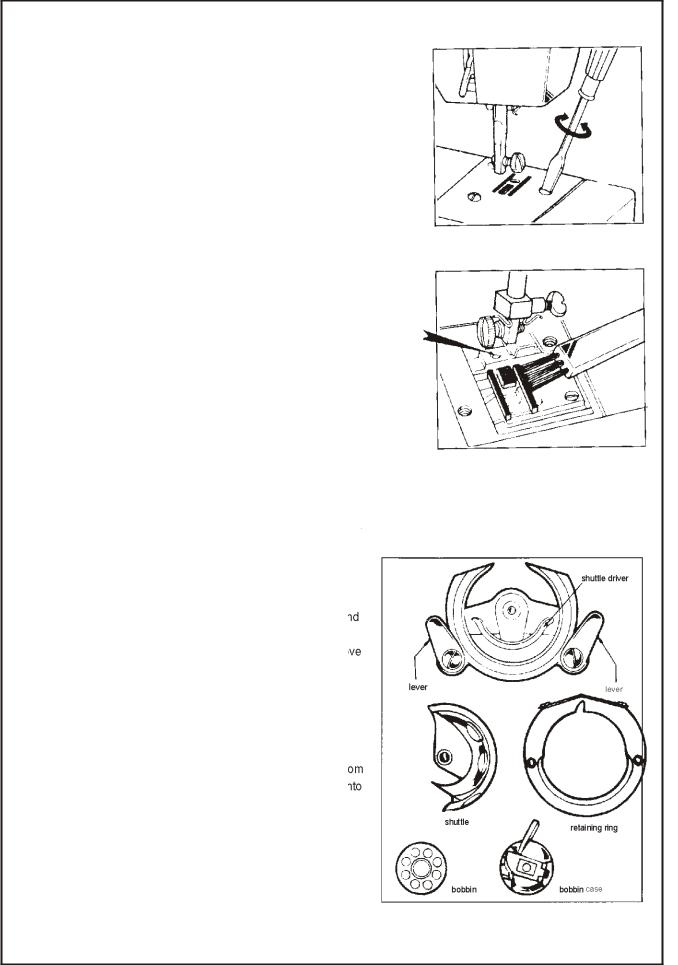
CLEANING THE FEED DOG
It is necessary to keep the feed dog teeth always cleaned in order to ensure smooth sewing.
1.Remove the needle and the presser foot.
2.Unscrew the needle plate set screws with a screw driver to take off the needle plate from the machine.
3.With a brush, clean out dust and lint clogged on the feed dog teeth.
4.Refit the needle plate.
CLEANING THE SHUTTLE RACE
Unplug the machine from the power supply.
To remove shuttle:
Raise needle to its highest position and remove bobbin case. Turn levers away from shuttle and lift out retaining ring shuttle, by grasping center pin.
Clean the reverse side of feed dog with a small brush. Remove lint and thread from all parts of shuttle and wipe with a lightly oiled cloth.
To reassemble: |
|
||
Hold |
shuttle |
by center pin and |
fit carefully back into shuttle |
race, |
forming perfect circle with |
shuttle driver.. |
|
Replace retaining ring polished |
side out, making sure the bottom |
||
pin fits into |
notch. Lock retaining ring by turning levers back |
||
position, Refit bobbin case with bobbin.
18
